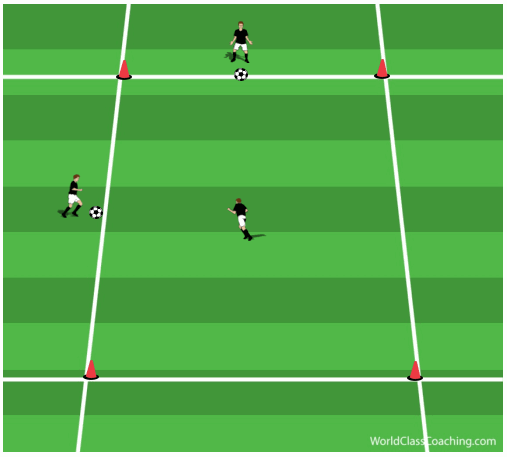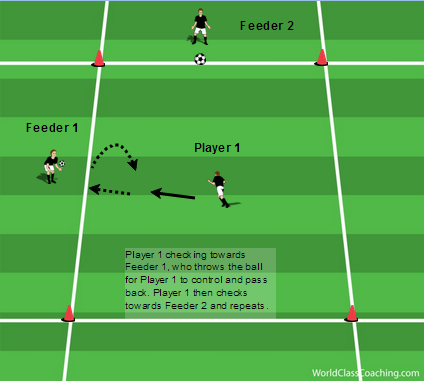By Daniel Severn
The first touch box is an exercise I love to use with all of my teams. With this exercise you can work on the players 1st touch from the air, on the ground, first time passing, volleying, heading, chest/thigh control – the possibilities are endless. Agility is a key aspect of the game that is developed thoroughly with this exercise due to the high tempo and constant changes of direction. It is also easy to add in competition to this exercise, having the players compete as teams, or against the players within their group, will only add to the intensity.
It can be used as either a Warm-Up or as the main Technical part of your session.
As there are so many aspects to this exercise; control, aerial control or first time passing/volleying, we can adjust accordingly to suit all age groups and levels. I will share some of these variations at the end of the article.
To start, you will need to divide your players into groups of 3. Two players will have a ball, one without. The two with the ball will stand on any two sides of the square. The third player will begin in the center of the square as shown below. I set up 4 of these squares all approx 5m x 5m, allowing 12 players to be involved at the same time – this number changes depending on the number of players in your practice.
The First Touch Box – 1. Set Up.
Here is how it works.
- The player MUST take two touches, no more-no less (regardless of height and pace of feed).
- One point is earned for every successful return to the feeder using two touches (control/volley OR control/pass).
- The winning player is the player in the square with the most points when time elapses.
- Time begins and ends on the coaches’ call or whistle. I recommend anywhere between 45 seconds to 2 minutes, dependent on age and ability levels.
- The active player alternates between the two feeders, he cannot receive two passes in a row from the same feeder.
I like to ask the players to challenge their team mates, without being cruel. By this I mean that I like the feeders to make the active player move to receive the ball as opposed to throwing the ball straight to them at a comfortable height every time. I.e. throw the ball to them at awkward heights; bounce it in; play it slightly off center.
This will keep the player on their toes and work a more match-like situation, as of course, it is rare that the ball travels directly towards the player trying to control it – the majority of the time, the player has to move and adjust their feet in order to give themselves a chance of controlling the ball.
I like to add the rule that the player MUST take 2 touches, regardless of pace and height of the delivery. This rule forces the player to adjust their feet quickly in order to give them the best chance of getting the ball under control with the first touch, in order to pass back with their second touch.
The First Touch Box – 2. Player in action.
Here are some of the variables:
- The time each player spends in the center of the square.
- Type of competition - You could have a number of squares competing against each other, for example, which player can successfully complete the most passes or to toughen up that challenge, how many successful passes can they make consecutively (back to 0 each time they miss-control or misplace a pass). Or you could have the players in each group competing against one-another in the same way, highest consecutive successful passes, total number of successful passes completed etc.
- One Touch. I will often run a ‘speed round’ after working with the 2 touch rule. My speed round is simply ‘One Touch Maximum’ in which the player must return the ball back to the feeder with their first touch.
- Three Touches. If you put in a three touch compulsory rule, it could slow things down slightly BUT it will get the players controlling the ball closely before shifting the ball to one side and passing – technique that becomes very important in crowded areas of the field.
- Body Parts – you can be specific “this time you must use only thigh control before passing the ball back”. Being specific with which body parts you ask the players to use will emphasize the development of that particular technique.
- You can also ask the feeders to move up and down the line of their square. This will mean the active player receives the ball on a different angle each time it is played in.
- The final variable is the size of the box. I use 5m x 5m squares. This allows for quick changes of direction and lot’s of first touches. A bigger area would allow for more running, less agility and less touches on the ball. If it’s the running/cardio you want to add….make the square bigger!
I hope you enjoy running the session!
Dan Severn, Program and Events Manager - BRASA Brazilian Soccer Academy




